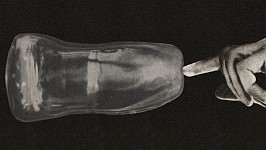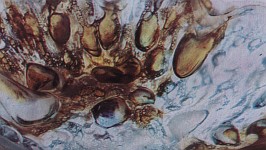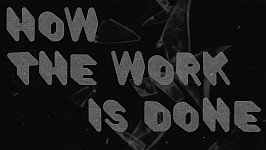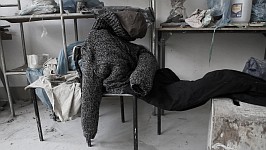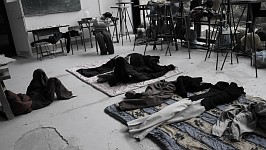Agnieszka Polska
Born 1985 in Lublin, lives and works in Berlin and Cracow.
Graduated from the Academy of Fine Arts in Cracow and Universitaet der Kunste Berlin.
Diploma – prof. Agata Pankiewicz’s photography studio.
Exhibitions (selected):
2011 Group Show, Federica Schiavo Gallery, Rome, Italy (forthcoming)
2011 Antje Majewski, The World of Gimel, Kunsthaus Graz, Austria (forthcoming)
2011 A Thousand Years of Modernity, BWA in Tarnów, Poland (forthcoming)
2011 Based in Berlin, KunstWerke Center for Contemporary Art, Berlin, Germany
2011 We Went to Croatan, Hardware Medien Kunstverain, Dortmund, Germany
2011 A Birdwatcher’s Passion. On Creating a Myth, CCA Sokół, Nowy Sącz, Poland
2011 The Promise, Galerie Crèvecoeur, Paris, France
2011 Transylvania 2, Arsenał, Poznań, Poland
2010 Early Years, KunstWerke Center for Contemporary Art, Berlin, Germany
2010 Vedo Cose Che Non Ci Sono, by the Museum of Contemporary Art in Warsaw, Rome, Italy
2010 Un seminaire a la campagne, France Fiction, Paris, France
2010 Multiplex, peer to space, Munich, Germany (curated by VVORK)
2010 Disobedience, Lmakprojects, New York, USA
2010 Good Old Days, Aarhus Kunstbygning, Aarhus, Denmark
2010 The Past Is a Foreign Land, Znaki Czasu Centre for Contemporary Art, Toruń, Poland
2009 Anabasis, Ludwik Grohman Villa, Łódź, Poland
2009 Freedom of Re-Cycling, Zachęta National Gallery of Art, Warsaw, Poland
2009 QU'EST-CE QUE C'EST DEGUEULASSE?, city installation, Vienna, Austria
2009 Polish Landscape, Contemporary Art Museum, Minsk, Belarus
2008 Ain't No Sorry, Museum of Modern Art in Warsaw, Poland
2008 Bewegte Stilleben, Kunstverein, Potsdam, Germany
2007 16 Things That May Not Happen, artpol, Cracow, Poland
Collective exhibitions (selected):
2011 Solo show, Żak Branicka Galerie, Art Basel Statements, Switzerland
2011 Gardener's Responsibility, Georg Kargl BOX, Vienna, Austria
2011 Duet, Goldex Poldex, Cracow, Poland (with Tomasz Kowalski)
2011 Garden, BWA Zielona Góra, Poland
2010 Solo show, Żak Branicka Galerie, ABC Berlin, Germany
2010 Three Videos with Narration, Bunkier Sztuki Gallery of Contemporary Art, Cracow, Poland
2010 Decades, Kunstmuseum Dieselkraftwerk Cottbus, Cottbus, Germany
2010 SPLACE, TV Tower, Berlin, Germany (with Antje Majewski)
2010 Three Videos with Narration, Zak | Branicka, Berlin, Germany
Links
www.agnieszkapolska.com
www.zak-branicka.com
www.georgkargl.com
Agnieszka Polska
is one of the most interesting young Polish artists. She is also one of the very few who are equally precise and meticulous in using the medium of collage and animated film when tackling the issues of affection, perception and reflection on the history of contemporary art with its social and political conditions. Her wonderfully ethereal, visually rich and intuitive narrations are characterised by an interesting use of the philosophical heritage of the 20th century, especially psychoanalysis.I am equally emotional about the film “Duet” (2011), prepared in co-operation with Tomasz Kowalski, which resembles a road movie and tells the story of lost customs from the former eastern borderlands of Poland. It resembles the poetics of the Swiss duo Fischli & Weiss, surrealist narrations by Maya Deren, or the latest project – “How the Work Is Done” (2011), also featuring in this year’s Geppert Competition. As it was the case with the “8th Syncretic Show”, the artist delves back in history. The picture is very simple, built on two interlacing levels: abstract animation with the image of a lump of liquid glass (as the narrator’s voice informs us, balancing between fact and fiction) and a human hand tackling the matter. It shows abstract close-ups of glass objects on a black background and a “veristic”, quasi-documentary staging of an Academy sculpture studio from 1956, where a strike was taking place. The artist does not inform us about the actual reasons for this action. Even though in fact the protest was fairly prosaic and concerned insufficient work space for the graduates, we believe the incident to have been par excellence political in nature. And this is the way Polska’s work appears to be in the context of her artistic sensitivity. The viewer’s eye follows it, re-distributing what is visible, sensual – to use Rancière’s terms – within the history of art understood as a socially committed discipline.
Ewa Małgorzata Tatar
